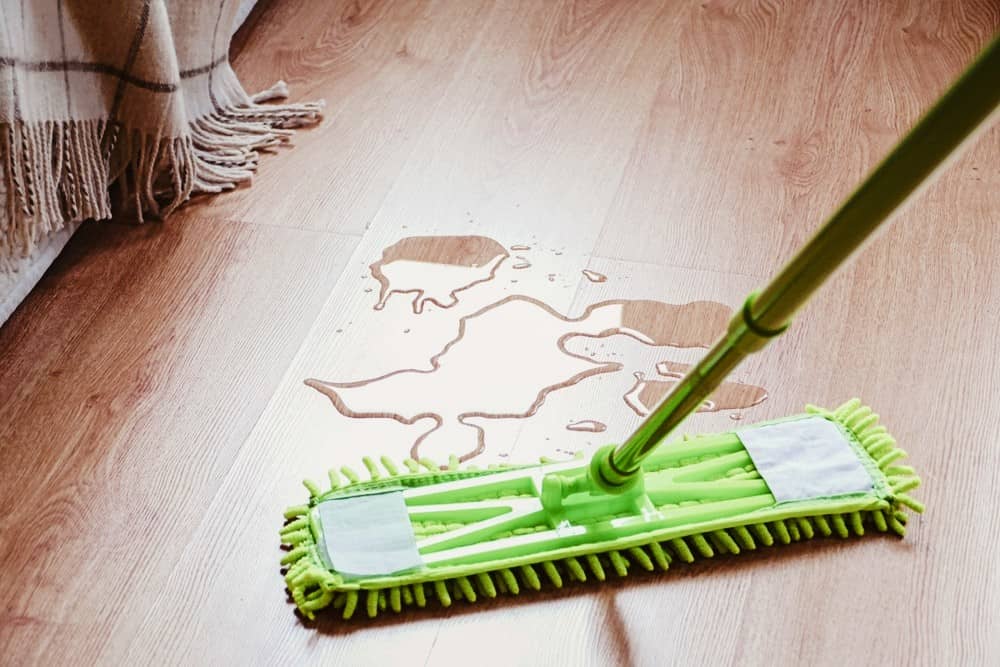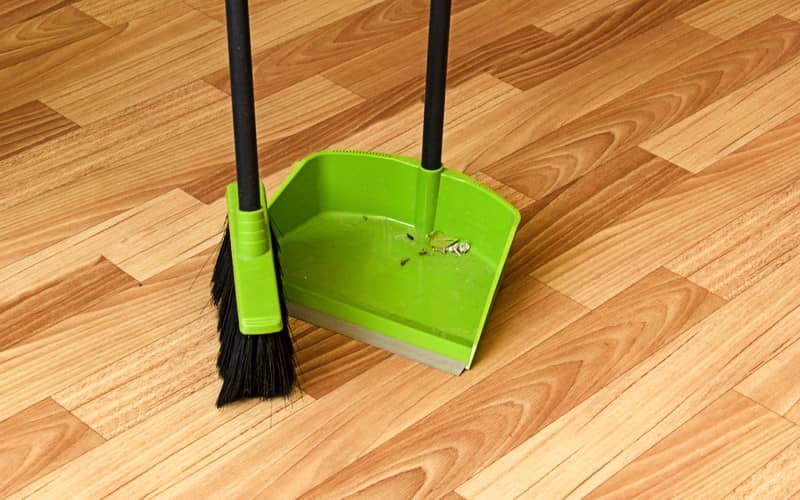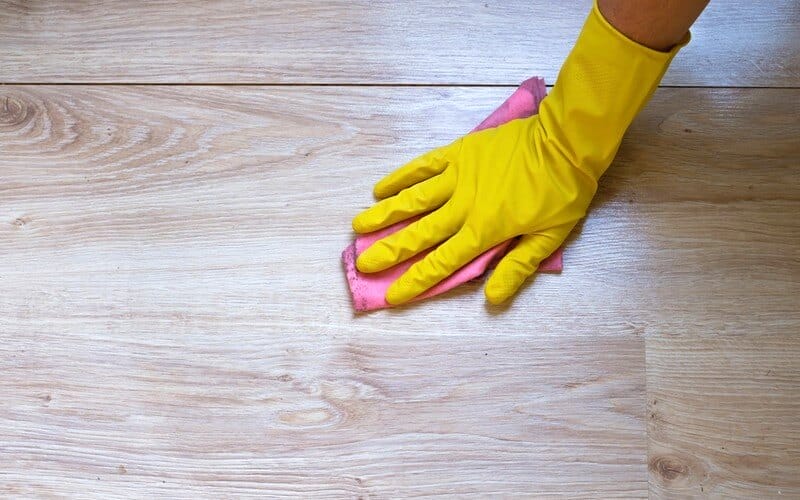If you love the look of traditional hardwood floors but don’t love the cost, there’s an inexpensive alternative — laminate flooring!
Laminate is cost-effective, durable, and low-maintenance. The planks can mimic the look of hardwood and other materials, and they’re easy to install.
Low-maintenance doesn’t mean no maintenance, though! If you want to keep your floors in good condition, knowing how to clean laminate floors is key.
Routine vacuuming or dry mopping keeps dirt at bay, while you should only damp mop for deep cleaning to lessen the risk of water damage.
Keep your laminate looking great so your floors are in a pristine state!
What to Clean With | How Often to Clean | Routine Cleaning | Deep Cleaning | Removing Stains and Scuff Marks | Floor Still Dirty After Mopping | Protecting Laminate Floors
Laminate vs Vinyl Plank Flooring
Both laminate and vinyl are floor materials that can create a desired aesthetic without breaking the bank. They’re often used to mimic wood, natural stone, and other more expensive flooring.
The two materials look alike, but there are some key differences between them!
| LAMINATE | VINYL |
| Made of several layers, including wood fibre or high-density fibreboard, resin, and print pattern | Made of several synthetic layers, such as acrylic, PVC, fibreglass, and print pattern |
| Has some degree of water resistance, but less than vinyl | Typically water-resistant or waterproof |
| Can be embossed or textured to create a more realistic appearance | May appear less realistic than laminate |
| Can only be dry mopped or damp mopped | May be wet mopped |
There’s no foolproof way to distinguish laminate from vinyl by sight, unless you can inspect the layers for wood fibres or fibreboards. However, vinyl floors tend to be thinner than laminate and may have little to no texture.
What is the Best Thing to Clean Laminate Floors With?
Laminate is fairly low-maintenance, so you can use simple cleaning solutions such as:
- Dish soap
- White vinegar
- Laminate-safe floor cleaner
No matter your cleaner of choice, make sure to minimise the moisture used. Too much water can cause warping, swelling, or even mould.
Opt for microfibre mops or cloths, which are more absorbent and less likely to scuff the surface. A microfibre spin mop even has a built-in mechanism for wringing out water!
Avoid harsh chemicals like bleach and abrasive cleaners like steel wool or scratchy brooms. Do not use oil- or wax-based products, as these can leave a residue on the floor or damage the finish.
If you’re unsure, contact the manufacturer or installer for instructions! Or leave your laminate floors (and the rest of the house) to an expert cleaner from Maid2Match — we know our stuff.
How Often to Clean Your Laminate Floors
To maintain your laminate floors, you should vacuum or dry mop at least once a week to lessen dirt buildup.
However, it’s better to sweep, vacuum, or dry mop several times a week, especially if you have pets or small children. Dust and debris can easily scratch or dull the laminate surface.
Deep clean laminate floors every 2–4 weeks by damp mopping.
Tackle any spills and messes immediately.
Tips for Routine Laminate Floor Cleaning
Sweeping, vacuuming, or dry mopping helps maintain the appearance of laminate flooring!
Try to do this at least once a week, although we recommend routine cleaning a few times a week, especially in high-traffic areas.
Dry mops are great since there’s less risk of scratching or scuffing. To properly use a dry mop, keep the pad flat to the floor and make long, overlapping passes from one side of the room to the other.
If you prefer sweeping, use a soft broom, not a straw one. For vacuums, use the soft brush or disengage the beater bar.
For any small stains, mix equal parts white vinegar and water in a spray bottle. Lightly spritz the stain, then wait a bit before wiping it off.
How to Clean Laminate Floors Without Leaving a Film
Keep in mind — when you’re deep cleaning laminate floors, you don’t want to use too much moisture!
Start by vacuuming or dry mopping the floors. This way, you won’t be pushing dust and dirt around with the mop.
In a mop bucket, mix one of the following solutions:
- 1/2 tsp dish soap in 3 litres of warm water
- 1 cup white vinegar in 3 litres of warm water
- Floor cleaning product (diluted per package instructions)
Have a separate bucket with plain water for rinsing.
Dip your microfibre mop into the cleaning solution, then wring it out so it’s just damp. Start in the corner furthest from the door and work in small sections, using gentle figure-8 strokes.
Rinse the mop head frequently as you go.
Once you’ve finished cleaning the entire floor, get a bucket with fresh water to wash off any remaining residue. Again, use a damp mop and gentle pressure.
To clean very dirty laminate floors, you may need to mop more than once or use a soft-bristled brush to scrub off stubborn grime.
Afterwards, let the floor air dry completely — open the windows to allow better ventilation if you can. Otherwise, go over the floor with a dry mop to remove any remaining moisture.
TIP: If there’s noticeable standing water left on the floor after a minute or two, your mop is too wet!
How to Get Rid of Stains and Scuff Marks
Did someone accidentally spill juice on the floor? Or maybe your toddler got too enthusiastic with their crayons.
Laminate is generally stain-resistant, but spots and scuffs do happen. They’re easier to get rid of when still fresh, so if you spot a mess, act fast!
Removing scuff marks
Heavy furniture, pet paws, or even dirty shoes can lead to scuff marks on a laminate floor.
To remove them, vacuum up any loose dirt around the area. Then use a dry microfibre cloth to buff the mark in small, circular motions.
If that doesn’t work, try a rubber pencil eraser or a tiny amount of silicone polish. Thoroughly clean the area afterwards!
Removing stains
Tackle spills and stains ASAP — the longer they sit, the harder they’ll be to remove, especially liquid messes.
Blot spills with a clean microfibre cloth or, for larger messes, wipe them away with a microfibre mop.
Afterwards, apply one of the following solutions to the type of stain:
- Diluted white vinegar: Coffee, red wine, food stains
- Mineral solvent: Grease, oil-based stains
- Plastic knife: Wax or gum
- Rubbing alcohol: Blood, crayon, ink, nail polish
Test your stain remover on an inconspicuous spot first to make sure it won’t damage or discolour the finish.
TIP: If you don’t have solvents, try a little nail polish remover!
Why is My Laminate Floor Still Dirty After Mopping?
If your laminate floor is still dirty or sticky after mopping, there are a few common culprits!
- Dirty mop
- Set-in stains
- Improper rinsing
- Wrong floor cleaner
- Dirty water while cleaning
To remove any lingering dirt or residue, try mopping with a vinegar solution! Mix 1 cup of white vinegar per 4 litres of water, then use that to mop the floor.
Always make sure the mop head is just damp, not wet! And regularly rinse the mop in a separate bucket of clean water.
Go over the floors with a damp mop and fresh water, then dry the floor ASAP.
Protecting and Maintaining Laminate Floors
Regular vacuuming or dust mopping does a lot in maintaining the appearance of laminate floors. If you remove loose dirt and debris, you help avoid scratching or dulling the finish.
Use protective pads underneath heavy furniture — like sofas or tables — to prevent the items from scuffing the laminate material.
If you have pets, trim their nails regularly so they don’t scrape the laminate.
Direct sunlight may cause fading or discolouration in laminate over time. Put up curtains or blinds (if possible) to diffuse the light, especially in the afternoon.
Keep your mop and bucket clean, too! Dirty tools will just track more grime onto your floors, undoing all your hard work.
FAQs About Laminate Floor Cleaning
Here are a few more things to know about cleaning laminate floors!
Which floor cleaner is best for laminate?
No need to get fancy — you can wash laminate floors with water and a little dish soap or white vinegar.
You can mix a few drops of dish soap in the white vinegar, but not too much! Soaps are slightly alkaline, so adding a large amount will reduce the effectiveness of the cleaning solution.
You can also use a laminate-safe floor cleaner.
What is the best mop for laminate floors?
You want to minimise moisture when mopping laminate, so the best mop to use is a microfibre spin mop.
Cotton mops tend to leave moisture behind, while sponge mops push water around that could seep into the laminate. Microfibre is very absorbent and won’t scuff the material.
Spin mops have an advantage since you can easily wring out excess water with the spinner!
Can you use a steam mop on laminate floors?
No, you should not use a steam mop on laminate flooring! The heat and water can cause warping, swelling, or moisture damage.
Excessive moisture could also loosen the adhesive or even lead to mould.




